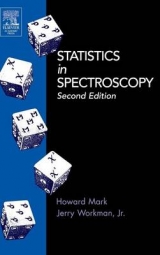
Statistics in Spectroscopy
Academic Press Inc (Verlag)
978-0-12-472530-0 (ISBN)
- Titel erscheint in neuer Auflage
- Artikel merken
This tutorial offers a basic hands-on approach to statistical analysis for chemists and spectroscopists. Without involving complicated mathematics, this book is designed to provide the reader with the basic principles underlying the use of common mathematical and statistical tools. Particular emphasis has been given to problem-solving applications and the proper use and interpretation of spectroscopic data. With exercises throughout, this book is also suitable for use as a textbook in analytical chemistry, instrumental analysis, and statistics in chemistry courses.
Howard Mark is President of Mark Electronics, Suffern, New York. He was previously affiliated as a Senior Scientist at Technicon Instrument Corp. in Tarrytown, New York. He holds a B.S. degree from City College of New York, an M.A. from City University of New York, and a PhD from New York University. His professional interests include instrument development, especially for spectroscopy; statistical and chemometric data analysis; and Custom software development, especially for implementation of data analysis algorithms. He received the 2003 Eastern Analytical Symposium Award for Achievement in Near Infrared Spectroscopy. He holds 6 U.S patents and has published 2 books and numerous book chapters. He has acted as Associate editor for the Handbook of Vibrational Spectroscopy, Wiley (2001). He has served as Past president of Council for Near-Infrared Spectroscopy (CNIRS), Treasurer of the New York section of the Society for Applied Spectroscopy, and as Past Chair of the New York section of the Society for Applied Spectroscopy. In addition he acts as Contributing editor and member of the Editorial Advisory Board of Spectroscopy. He has published over 150 peer-reviewed papers dealing with design and development of scientific instrumentation, new concepts in computerized instrumentation and data analysis. Jerry Workman, Jr. is Chief Technical Officer and Vice President of Research& Engineering at Argose Inc., Waltham, MA. In his career, Workman hasfocused on molecular and electronic spectroscopy and chemometrics. He haspublished over 200 scientific papers, 7 text volumes, and over 20 patents,patents pending, and trade secrets. He received the B. A. degree in naturalsciences and M. A. degree in biological sciences and genetics from SaintMary's University of Minnesota, and the Ph.D. degree in biological chemistryfrom Columbia Pacific University. He has completed technical managementcertificates from Columbia University and MIT. He is a Fellow of theAmerican Institute of Chemists, the American Society for Testing andMaterials International, and the Royal Society of Chemistry. In 2002 he wasthe recipient of the ASTM International Award of Merit; IBC InternationalScientist of the Year; and the Eastern Analytical Symposium Award forOutstanding Achievements in the Field of Near Infrared Spectroscopy.
Introduction. Important Concepts from Probability Theory. Populations and Samples: The Meaning of "Statistics." Degrees of Freedom. Introduction to Distributions and Probability Sampling. The Normal Distribution. Alternative Ways to Calculate Standard Deviation. The Central Limit Theorem. Synthesis of Variance. Where Are We and Where Are We Going? More and Different Statistics. The t Statistic. Distribution of Means. One- and Two-Tailed Tests. Philosophical Interlude. Biased and Unbiased Estimators. The Variance of Variance. Hypothesis Testing of Chi-Square. More Hypothesis Testing. Statistical Inferences. How to Count. And Still Counting. Contingency Tables. What Do You Mean, Random? The F Statistic. Precision and Accuracy: Introduction to Analysis of Variance. Analysis of Variance and Statistical Design of Experiments. Crossed and Nested Experiments. Miscellaneous Considerations Regarding Analysis of Variance. Pitfalls of Statistics. Pitfalls of Statistics Continued. Calibration in Spectroscopy. Calibration: Linear Regression as a Statistical Technique. Calibration: Error Sources in Calibration. Calibration: Selecting the Calibration Samples. Calibration: Developing the Calibration Model. Calibration: Auxiliary Statistics for the Calibration Model. The Beginning.
| Erscheint lt. Verlag | 17.4.1991 |
|---|---|
| Verlagsort | San Diego |
| Sprache | englisch |
| Maße | 151 x 229 mm |
| Gewicht | 630 g |
| Themenwelt | Mathematik / Informatik ► Mathematik ► Angewandte Mathematik |
| Mathematik / Informatik ► Mathematik ► Statistik | |
| Naturwissenschaften ► Chemie ► Analytische Chemie | |
| ISBN-10 | 0-12-472530-9 / 0124725309 |
| ISBN-13 | 978-0-12-472530-0 / 9780124725300 |
| Zustand | Neuware |
| Haben Sie eine Frage zum Produkt? |
aus dem Bereich



